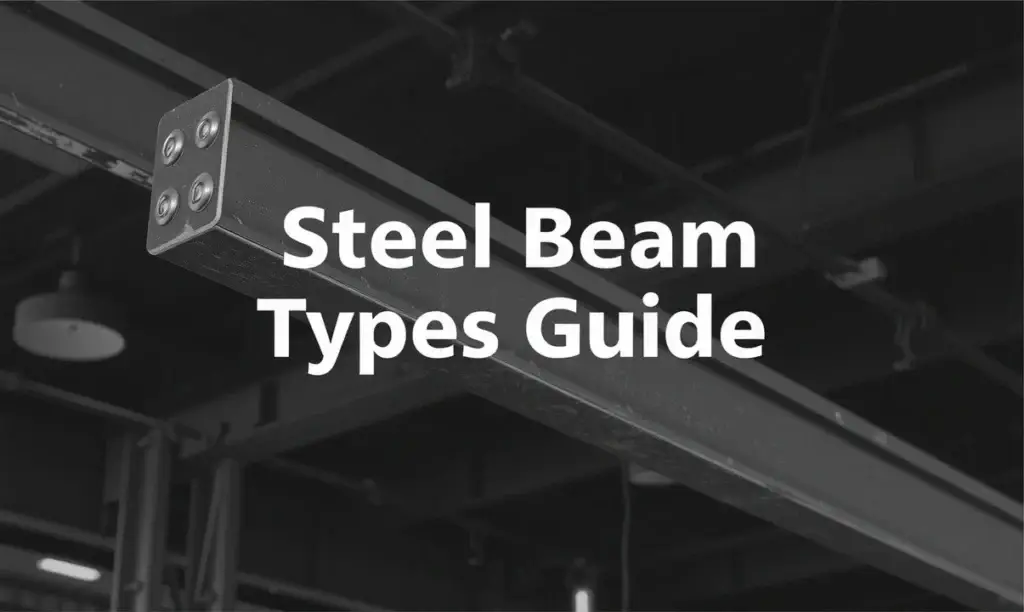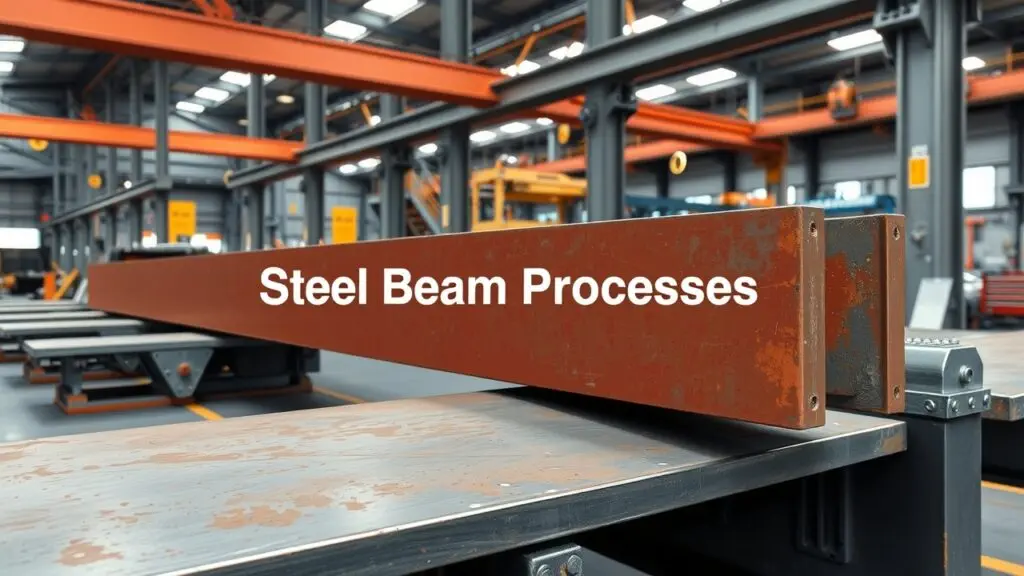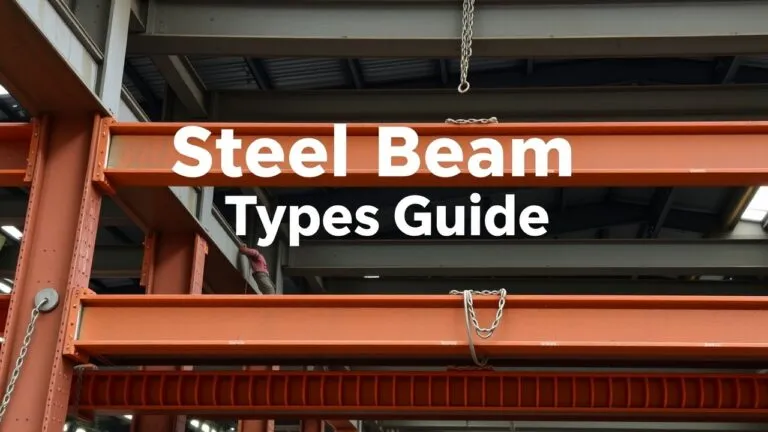This guide covers various types of steel beams (I-beams, H-beams, etc.), their sizes, grades, and applications in construction, helping you select the right beam for your project.
What are Steel Beams?

Steel beams are strong pieces made from steel. They hold up loads in buildings and other structures. These beams come in many shapes and sizes for different uses. Common types of steel beams include I-beams, H-beams, and wide flange beams. Each shape has a specific purpose to ensure strength while being lightweight.
The main job of steel beams is to carry loads from one part of a structure to another. This means they support things like the weight of floors and roofs, as well as side forces from wind or earthquakes. You can find steel beams in all kinds of places—homes, office buildings, bridges, and factories.
When working on big projects where strength is key—like tall buildings or large spaces—picking the right beam is super important. It helps keep everything safe and running smoothly. Knowing about the different types of beams allows builders to create structures that look good and work well.
Importance of Correct Steel Beam Selection
Choosing the right steel beam is crucial for safety in any building project. Each beam has special features that affect how much weight it can hold. Picking the wrong one can lead to serious problems like building failures.
Efficiency also matters when selecting steel beams. A well-chosen beam reduces waste and maximizes strength without adding extra weight. This not only helps with performance but also cuts costs during construction.
Cost is another factor when choosing a beam type. This means looking at how much the beam costs now compared to how long it will last without needing repairs. Spending more on quality materials upfront might save money later because they last longer.
Types of Steel Beams Covered in This Guide
In this guide, we will talk about several common types of steel beams used in construction:
- I-Beams: Shaped like an “I,” these are strong and good at bending.
- H-Beams: Similar to I-beams but with wider flanges for added stability.
- S-Beams: Known as American Standard Beams; they have sloped flanges.
- C-Beams: Shaped like a “C,” often used in channels.
- L-Beams: Formed into an “L” shape for corner supports.
- T-Beams: Shaped like a “T,” they provide extra support at edges.
- Box Beams: Hollow rectangular shapes that resist twisting.
- Plate Girders: Made from plates welded together for heavy loads over long distances.
Knowing these different types helps those in construction or design fields make smart choices based on what each project needs for strength and use.
Wide-Flange Beams (I-Beams & H-Beams)
I-Beam Description
I-beams, also called wide flange beams or universal beams, are steel beams shaped like the letter “I”. They have two horizontal parts, known as flanges, connected by a vertical part called the web. This design helps them carry heavy loads without being too heavy themselves. The size and shape of I-beams can change based on what they are used for. They are common in construction because they combine strength and lightness well.
I-Beam Material Properties
The materials used to make I-beams are very important for their performance. Common steel grades include A36 and A992.
- A36 Steel: This type is known for being easy to weld and machine. It has a yield strength of 36 ksi, making it good for many construction projects.
- A992 Steel: This grade is often used for building frames because it has a higher yield strength of 50 ksi. It also performs better at high temperatures.
High-strength steel options are available as well, which allow engineers to create lighter structures without losing safety.
I-Beam Uses
I-beams have many applications across different fields:
- Building Frames: They provide key support in both residential and commercial buildings.
- Bridges: Their strong design makes them perfect for bridge construction, where they need to support heavy weights over long distances.
- High-Rise Construction: In tall buildings like skyscrapers, I-beams help maintain stability while creating open spaces inside.
Choosing the right beam type is essential for each specific project.
I-Beam Advantages and Disadvantages
When looking at different kinds of steel beams like I-beams, it’s key to think about both the pros and cons:
Advantages:
- Load-Bearing Capacity: They can support heavy weights with little bending.
- Structural Support: They offer strong support over long distances without needing too much material.
- Lightweight Design: Compared to solid beams, they weigh less which can help reduce overall building weight.
Disadvantages:
- Buckling Risk: If designed too slim, they might buckle when under compression forces.
- Corrosion Susceptibility: If not treated or coated properly, steel can rust when exposed to moisture or chemicals.
Knowing these factors helps builders choose the best type for their projects.
H-Beams: Clarifying the Relationship with Wide Flange Beams
H-beams are similar to wide flange beams but have some differences in shape. Both types have flanges that run parallel; however:
- H-beams usually have wider flanges than standard I-beams. This feature improves stability when under load.
The interchangeability between wide flange beams and H-beams gives engineers more options when designing structures. Both can serve similar purposes depending on specific needs or design choices in a project context.
Other Common Steel Beam Types
S-Beams (American Standard Beams)
S-beams, or American Standard beams, are a popular choice in construction. Their “S” shape is easy to spot and offers great strength while staying lightweight. These beams have a low height-to-width ratio and a uniform thickness for both the flange and web.
Uses:
- Bridges
- Buildings
- Structures requiring solid load-bearing capacity
Advantages:
- Cost-effective: Usually cheaper than I-beams because they are easier to make.
- Versatile: Can fit into many different structural applications.
Disadvantages:
- Lower Load Capacity: I-beams typically carry more weight effectively.
- Limited Height Options: There aren’t as many sizes, which can limit design options.
C-Beams (Channel Beams)
C-beams, also known as channel beams, have a “C” shaped cross-section. This shape provides good resistance against bending forces. They are light but strong enough for various tasks.
Uses:
- Framing systems
- Bracing elements
- Supporting walls or roofs
Advantages:
- Lightweight Design: Easy to handle during installation.
- Good Structural Integrity: Offers solid support with less material.
Disadvantages:
- Less Efficient Load Distribution: I-beams do this better because they spread loads more evenly.
- Limited Heavy Load Applications: Not the best choice for very heavy loads over long distances.
L-Beams (Angle Beams)
L-beams, often called angle beams, form an “L” shape with two legs. They’re great when lightweight steel solutions are needed without losing strength.
Uses:
- Brackets
- Frames
- Supports in tight spaces
Advantages:
- Compact Size: Fits well in small areas while still offering support.
- Easy to Fabricate & Install: Simple shapes make assembly quick and easy.
Disadvantages:
- Reduced Load-Bearing Capacity vs. I-Beam Designs: While effective for some uses, they can’t handle as much weight as I or H beams.
T-Beams
T-beams have a T-shaped cross-section that combines features of slab floors and traditional beam designs. This makes them great for concrete slabs that rest on top of them.
Uses:
Often used in floor systems where concrete slabs sit on these steel members to improve strength and reduce deflection under heavy loads.
Box Beams
Box beams have a hollow rectangular section which gives them excellent stiffness and load capacity due to their enclosed design.
Fabrication Techniques:
They are usually made by welding plates together into box shapes, ensuring high strength-to-weight ratios that work well for large buildings and warehouses.
M-Beams (Miscellaneous Shapes)
M-beams include custom-cut steel sections made for specific project needs rather than standard designs.
Overview:
These flexible options address special engineering challenges while allowing for creative designs that blend function with style.
Plate Girders
Plate girders are constructed from flat plates welded together, making them very strong structures that can span large distances without needing extra support—perfect for bridges!
Fabrication Methods:
Welding is the main method used here, ensuring all parts fit together tightly for added durability across different environments faced by infrastructures today!
Steel Beam Manufacturing Processes
Hot-Rolled Steel Beams
Hot-rolled steel beams play a vital role in construction and engineering. The process starts by heating steel billets to over 1,700°F (926°C). This heat makes the steel soft and easy to shape. After heating, workers pass the billets through rollers that form them into different beam types, like I-beams or H-beams.
This hot-rolling method shapes the beams while also improving their internal structure. The heat aligns the steel’s grain, which boosts its strength and flexibility compared to cold-formed beams. After shaping, the beams cool down at room temperature. This cooling helps enhance their properties even more.
A diagram of this process usually shows several steps: heating, rolling through mills, cooling, and cutting to length.
Welded Steel Beams
Welded steel beams are made from flat pieces or plates joined using welding methods. The process begins by selecting raw materials based on what is needed for the design. These materials can be rolled sections or flat sheets of steel.
Next, workers cut these materials to size and arrange them according to engineering plans. Different welding techniques—like MIG (Metal Inert Gas), TIG (Tungsten Inert Gas), or submerged arc welding—are used depending on how thick the material is and how joints are configured.
After welding, these structures go through quality checks. Non-destructive testing methods like ultrasonic testing or radiography ensure they are safe before installation.
A diagram of this process would show steps such as cutting materials, assembling parts into frames, applying welds at joints, and performing quality tests after welding.
Comparison of Hot-Rolled vs. Welded Beams
When comparing hot-rolled beams and welded beams for construction projects, several important factors come into play:
| Feature | Hot-Rolled Beams | Welded Beams |
|---|---|---|
| Manufacturing Process | Shaped directly from heated billets | Assembled from multiple pieces |
| Strength | Generally stronger due to uniformity | Strength varies based on weld quality |
| Cost-effectiveness | Typically lower production costs | May incur higher labor costs |
| Applications | Used in large-scale projects | Suitable for custom designs |
Both types have unique benefits suited for different needs in structural design. Hot-rolled beams are efficient for mass production while welded beams offer more options for complex designs tailored for specific uses.
Steel Beam Grades and Specifications
When picking steel beams for construction, it’s important to know about different grades and specifications. Each steel grade has its own special properties that make it good for certain uses.
Common Steel Grades
Here are some of the most common steel grades used in construction:
- ASTM A36: This grade is well-liked for general structural work. It’s easy to weld and has moderate strength.
- ASTM A992: This one is great for building frames. It offers high strength and good weldability, making it a favorite choice.
- ASTM A572-50: This grade has a higher yield strength than A36. It resists deformation well while still being ductile.
- ASTM A709-50: Made for bridges, this grade combines high strength with toughness even in cold conditions.
- ASTM A529-50: It strikes a balance between strength and ductility. This makes it versatile for various applications.
Selecting the Right Steel Grade for Specific Applications
Choosing the right steel beam involves thinking about several things like load-bearing capacity, environmental factors, how it’s made, cost, and what it will be used for.
For example:
- If you’re building a frame that needs to handle heavy loads or forces like wind,
You might want to choose higher-grade steels like ASTM A992 because they perform better under pressure. - If you’re working with a tight budget and don’t have huge demands,
Using a lower-grade option like ASTM A36 might work without risking safety.
By carefully thinking about these factors and checking the specifications from trusted sources, professionals can make smart choices that improve both safety and efficiency in projects involving steel beams.
Steel Beam Selection Criteria

When picking steel beams for building projects, it’s key to think about a few important things. These factors help make sure the structure is strong and works well. Here are the main points to consider when choosing different kinds of steel beams.
Load-Bearing Requirements (Dead Load, Live Load, Wind Load)
Knowing load-bearing needs is super important in beam selection. The dead load is the weight of the structure itself, including all permanent parts. The live load is about temporary weights, like people and furniture. Plus, we can’t forget about wind loads, especially for buildings in windy areas; they can really affect safety and stability.
To find out if a beam can handle the weight, you need to calculate its load-bearing capacity. This capacity should be more than what you expect from dead and live loads and should also consider wind effects if needed. Checking engineering rules or guidelines will give you the details for these calculations.
Span Length and Beam Deflection
The distance between supports plays a big role in how well a beam works. Longer spans might need larger or stronger beams to avoid too much bending or deflection.
Beam deflection can depend on several things:
- Bending moment: This is the internal moment created by outside loads.
- Shear stress: This is when forces act parallel to the material’s cross-section.
Engineers usually look at limits for allowable deflection based on span lengths when choosing the right steel beams.
Budget and Material Costs
Cost matters a lot when picking steel beams. Prices can change a lot based on what type of material you choose (like rolled versus fabricated), size, and market conditions at that time. To keep your project budget-friendly:
- Look at total project costs compared to what you have available.
- Think about long-lasting durability against upfront costs—spending more now might save money later with less maintenance.
Always get multiple quotes from suppliers before making final choices about materials.
Accessibility and Installation Ease
How easy it is to install steel beams can impact labor costs and how long the project takes. Things that affect installation include:
- Weight: Heavier beams may need special equipment.
- Shape: Some designs are easier to handle than others.
Checking site accessibility early helps make sure chosen materials fit with what’s possible during installation.
Aesthetic Considerations
Besides practical needs, looks matter in architectural design using steel beams. Designers often want certain styles or finishes that match the building’s overall appearance while keeping things functional.
Choosing nice-looking options not only improves how spaces look but also makes them better for people using those spaces.
Step-by-Step Guide for Beam Selection
Choosing the right type of steel beam involves several steps:
- Identify load requirements based on what it’ll be used for.
- Figure out how long spans need to be between supports.
- Look at budget limits along with material availability.
- Think about accessibility issues related specifically to installation.
- Consider aesthetic choices that fit architectural goals.
- Consult engineers throughout this process—they have valuable expertise for all these decisions!
By following these tips closely while working together with everyone involved—from designers to builders—successful outcomes become much more likely!
Steel Beam Installation and Best Practices
Steel beams are a big deal in construction. They provide strong support for buildings and other structures. When done right, steel beam installation keeps everything safe and up to code.
Proper Handling and Storage to Prevent Damage
Handling steel beams takes care. It’s important to avoid damage that can affect their strength. Use cranes or forklifts made for heavy lifting when moving them around.
When storing beams, put them on flat ground. This helps stop them from bending or warping over time.
Corrosion can be a problem too. Keep the beams dry and shield them from moisture using tarps or protective coatings. Doing this will help the beams last longer and keep their strength.
Accurate Measurement and Calculation Importance
Getting measurements right is super important. If beams don’t fit, it can mess up the whole project! Load calculations need to consider both live loads (like people) and dead loads (like the weight of the beam itself).
Engineers have to pay close attention to beam sizes, since small mistakes can lead to big issues later on. Using design software can help make these calculations more accurate, making sure you choose the right type of steel beams for your needs.
Proper Fastening Techniques
Fastening techniques are key to a stable structure with steel beams. Common methods include:
- Welding: Creates strong permanent joints.
- Bolting: Allows flexibility during assembly.
- Riveting: A traditional method still used for certain jobs.
Each method has its perks based on how much load is expected, weather conditions, and how easy it is to reach during installation.
Importance of Regular Inspection for Structural Integrity
Regular inspections are crucial for keeping installed steel beams safe over time. Setting up inspection plans helps find problems early, like rust or fatigue that could harm performance later on.
Maintenance should involve simple visual checks as well as deeper inspections using special tools if needed. Catching wear early can save lots of trouble later on by keeping everything safe and sound.
FAQs about Steel Beams
What types of steel beams are available?
Common types include I-beams, H-beams, S-beams, C-beams, L-beams, T-beams, box beams, and plate girders.
How are steel beams classified?
Steel beams are classified based on shape (I, H, S, C) and dimensions. They follow standards set by organizations like ASTM.
What factors influence steel beam selection?
Factors include load capacity, span length, material costs, installation ease, and design aesthetics.
What are the key properties of steel beams?
Key properties include yield strength, tensile strength, ductility, and corrosion resistance.
Where can I find specifications for steel beams?
Specifications can be found through the American Institute of Steel Construction (AISC) and related engineering codes.
What is the difference between hot-rolled and cold-formed steel beams?
Hot-rolled beams are formed at high temperatures for structural integrity. Cold-formed beams are shaped at room temperature for lighter applications.
What is the significance of beam weight in construction?
Beam weight impacts load-bearing capacity and transportation costs. Lighter beams reduce overall structure weight.
How does beam design affect structural safety?
Proper beam design ensures that structures can withstand forces like wind and gravity without failure.
What are common applications for steel beams?
Applications include residential buildings, commercial structures, bridges, industrial infrastructure, and transportation projects.
How do I calculate the load capacity of a steel beam?
Load capacity calculations involve assessing dead loads and live loads while considering beam dimensions and material properties.
Understanding Steel Beam Profiles
- Universal Columns: Used in vertical support applications.
- Angle Beams: Effective for bracing or framing.
- Box Beams: Provide high torsional resistance.
- Channel Beams: Versatile for various construction needs.
- WT Beams: Feature wide flanges for enhanced stability.
- ST Beams: Lightweight options ideal for non-load bearing uses.
- Rolled Steel Beams: Standardized shapes commonly used in construction.
- Fabricated Steel Beams: Custom-cut solutions tailored to specific projects.
- Composite Steel Beams: Combine materials for improved performance.
- Tapered Flange Beams: Offer efficient weight distribution in spans.
- Untapered Flange Beams: Standard shapes that provide uniform support.
These points help broaden understanding of various steel beam types relevant to construction and engineering contexts.
Related Topics
- types of steel beam grades
- types of steel beam connections
- types of beam supports
- types of load-bearing structures
- types of structural steel
- types of beam fabrication methods
- types of steel beam applications
- types of building materials
- types of construction materials



Types of Steel Beams: A Comprehensive Guide